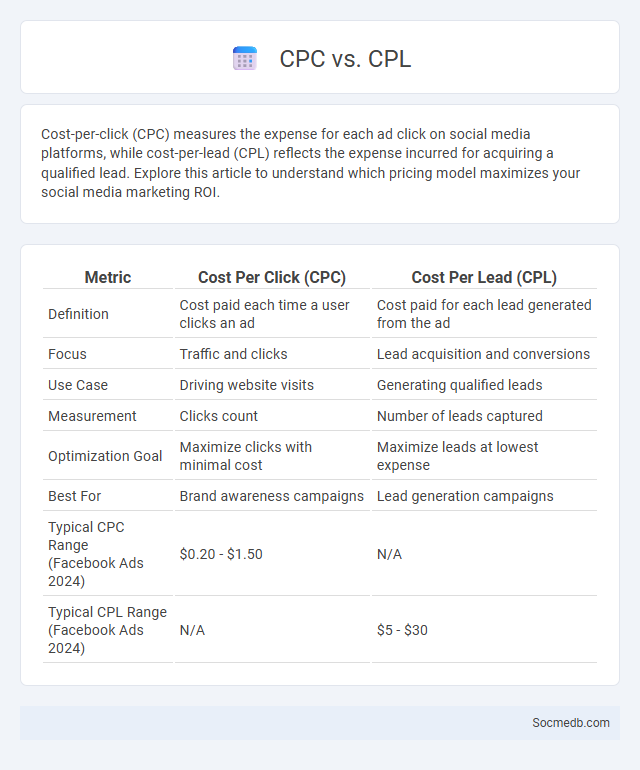
Photo illustration: CPC vs CPL
Cost-per-click (CPC) measures the expense for each ad click on social media platforms, while cost-per-lead (CPL) reflects the expense incurred for acquiring a qualified lead. Explore this article to understand which pricing model maximizes your social media marketing ROI.
Table of Comparison
| Metric | Cost Per Click (CPC) | Cost Per Lead (CPL) |
|---|---|---|
| Definition | Cost paid each time a user clicks an ad | Cost paid for each lead generated from the ad |
| Focus | Traffic and clicks | Lead acquisition and conversions |
| Use Case | Driving website visits | Generating qualified leads |
| Measurement | Clicks count | Number of leads captured |
| Optimization Goal | Maximize clicks with minimal cost | Maximize leads at lowest expense |
| Best For | Brand awareness campaigns | Lead generation campaigns |
| Typical CPC Range (Facebook Ads 2024) |
$0.20 - $1.50 | N/A |
| Typical CPL Range (Facebook Ads 2024) |
N/A | $5 - $30 |
Understanding CPC, CPL, and Ad Auctions
Cost Per Click (CPC) and Cost Per Lead (CPL) are critical metrics in social media advertising that measure the effectiveness and efficiency of ad campaigns by tracking expenses related to user clicks and lead generation respectively. Ad auctions on platforms like Facebook and Google determine which ads appear based on bid amounts, ad quality, and relevance, ensuring advertisers reach their target audience while optimizing costs. Mastering these elements enables marketers to maximize ROI by allocating budgets toward high-performing ads that generate engagement and conversions.
Key Differences Between CPC and CPL
Cost Per Click (CPC) charges advertisers based on the number of clicks their ads receive, emphasizing user engagement without guaranteeing conversions, while Cost Per Lead (CPL) focuses on paying only when a user completes a desired action such as filling out a form or signing up for a newsletter, ensuring higher quality interactions. CPC models typically suit campaigns aiming for broad reach and traffic generation, whereas CPL campaigns are tailored for lead generation and conversion optimization. Understanding these differences helps marketers allocate budgets effectively to maximize ROI on social media advertising.
How Ad Auctions Work
Ad auctions on social media platforms operate by matching advertisers' bids with user data to deliver targeted ads. Algorithms analyze factors such as bid amount, ad quality, and relevance score to determine the winning ad that appears in users' feeds. This system optimizes revenue for platforms like Facebook and Instagram while ensuring users see personalized and engaging content.
Benefits of Using CPC Campaigns
CPC campaigns on social media platforms optimize your advertising budget by charging only when users click on your ads, ensuring cost-effective lead generation. These campaigns provide precise targeting options, allowing you to reach specific demographics and increase conversion rates. By leveraging detailed analytics, you can continuously refine your strategy to maximize your ROI and grow your online presence efficiently.
Advantages of CPL Advertising
Cost Per Lead (CPL) advertising on social media offers precise targeting capabilities that significantly improve lead quality and conversion rates. By focusing on generating actionable leads rather than impressions or clicks, CPL campaigns maximize return on investment (ROI) for businesses. Enhanced tracking and data analytics enable continuous optimization, ensuring campaigns effectively reach and engage potential customers.
Ad Auction Mechanics: Bidding and Ranking
Social media ad auction mechanics rely on real-time bidding where advertisers compete by setting bids for ad placements targeting specific audiences. The platform ranks bids based on a combination of bid amount, ad quality score, and expected user engagement to determine which ads are shown. This ranking system ensures advertisers with relevant, high-quality ads achieve better visibility and performance within user feeds.
When to Choose CPC Over CPL
Choose CPC (Cost Per Click) over CPL (Cost Per Lead) when your primary goal is to drive traffic and increase brand awareness quickly, as CPC charges you only when users click on your ads. CPC campaigns are ideal for testing ad creatives and targeting strategies, allowing you to optimize for engagement before committing to lead generation. If your focus is on maximizing website visits and gauging audience interest, CPC offers a cost-effective approach to measure performance and adjust your Social Media marketing tactics accordingly.
Impact of Ad Auctions on Campaign Performance
Ad auctions on social media platforms significantly influence campaign performance by determining ad placement and cost efficiency based on bids, relevance, and user engagement metrics. Higher auction scores lead to increased visibility, driving better click-through rates and conversion outcomes while optimizing advertising budgets. Understanding auction algorithms and continuously refining targeting strategies enhances overall return on investment (ROI) for social media campaigns.
Optimizing Campaigns for CPC and CPL
Optimizing social media campaigns for Cost Per Click (CPC) and Cost Per Lead (CPL) involves leveraging precise audience targeting, compelling ad creatives, and continuous A/B testing. Utilizing advanced analytics tools to monitor user engagement metrics enables marketers to adjust bids and allocate budgets effectively, reducing CPC and improving lead quality. Implementing retargeting strategies and optimizing landing pages further enhances conversion rates, ensuring lower CPL and higher campaign ROI.
Final Thoughts: Choosing the Right Model for Your Goals
Selecting the appropriate social media model depends on your specific business objectives, target audience, and content strategy, with platforms like Instagram excelling in visual engagement while LinkedIn suits B2B networking and professional growth. Analyzing key metrics such as engagement rate, reach, and conversion rates helps determine the model's effectiveness in meeting your marketing goals. Prioritizing platforms that align with your brand voice and audience behavior ensures optimized results and sustained online presence.
 socmedb.com
socmedb.com